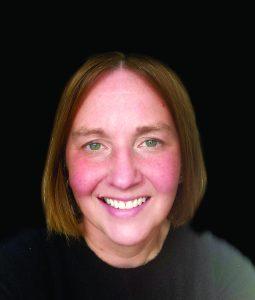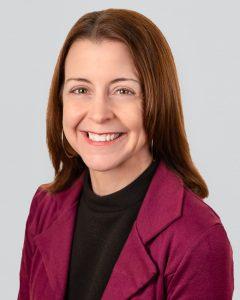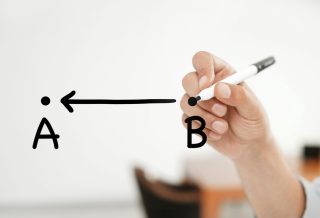FOCUS
Connecting across grades helps teachers close student learning gaps
By Suzanne Bouffard
Categories: Collaboration, Instructional materials/curriculum, Learning designs, Teacher leadershipJune 2023
To accelerate learning with just-in-time support, educators need a set of skills and knowledge about the continuum of student learning and development over time. Vertical alignment of concepts and skills across grade levels is one way to develop that knowledge base and determine what students know, what they have already learned, and what they need to know.
The Learning Professional recently spoke with two mathematics professional learning experts about the role of vertical alignment and how to support teachers to facilitate it. Nicole Marshall is an education associate in secondary mathematics at the Delaware Department of Education, where she oversees professional learning and support for the state’s mathematics coaches. Andrea Gautney is a math instructional coach for Clear Springs High School in Clear Creek Independent School District in Texas, where she partners with teachers and teams to provide support and build capacity in all facets of the classroom. She also serves as a Learning Forward consultant, working with school districts on instructional coaching.
Why is acceleration a valuable approach to close students’ learning gaps?
Nicole Marshall: First, we need to understand and wrap our minds around why remediation doesn’t work and will never work if we want to close the gap in opportunities for learning grade-level content. If we discuss that piece, the need for changing our actions will be far more understood and have more buy-in.
If we’re always remediating certain students, those students won’t ever have the opportunity to get past the gaps. There are many analogies to explain this. One I read recently was a sports analogy: If you take the kids who are struggling with game play and always pull them out and they never have time with the coach, they’ll never improve. We need that understanding in order to create the need to change and do something else.
Remediation is like taking the kids who are struggling with game play and always pulling them out. If they never have time with the coach, they’ll never improve. #TheLearningPro #EdChat #StudentSuccess Share on XWe know that there are some students who may struggle with specific topics within the content. This does not mean they struggle with all of mathematics. A student in 8th grade, for example, may struggle with a mathematics topic relating to congruence and similarity. We (the educators) need to dig into the mathematics and determine the learning and understanding that lead in to this topic in order to assess where the student is struggling and determine the support to be provided for this student to ultimately engage with the grade-level mathematics.
How is vertical alignment across grades important for acceleration?
Marshall: Vertical alignment and understanding the vertical articulation (of content across grade levels) is a necessary component to address acceleration. The classroom teacher as a content expert needs to rely on not only their knowledge of the content they’re teaching but also those foundational elements (from prior grades) that a student might be struggling with.
And not only is what students learned historically important for building grade-level knowledge, but how they learned it. (For example,) in elementary school, students are learning and demonstrating math through modeling with manipulatives and diagrams. When these students move into middle school, rather than jumping straight into algorithms, we should be providing opportunities to connect those models and diagrams, to connect not only the content of their previous learning, but also the pedagogical content knowledge. It might not be that students don’t know the information or have the knowledge, but rather they articulate it differently.
How do you help teachers understand the importance of vertical alignment?
Andrea Gautney: I’ve been working with content-area teams as well as individual teachers, starting with understanding what students do and don’t already know. We’ve had a lot of conversations about preassessment as formative assessment. 
In PLC (professional learning community) meetings (when we are planning instruction for the beginning of the school year), I ask, “Why are we placing two days in the calendar to reteach and then retest (concepts from previous grades)?” The teachers say, “They’re not going to be able to do it. I already know.” They’re planning for remediation instead of responding to student needs.
So we talk about the value of preassessment and about shifting forward one of those days we’ve allocated to reteaching to come after the formative assessment, when we know what students need. (Historically) we’ve been resisting this idea of preassessing the prior knowledge skills because we think it will take too long. But the active engagement in this preassessment might reignite students’ understanding or give them some idea of what they do remember or know how to do so we can see a starting point.
One way to accelerate learning is to put relevant concepts in front of the students in the right order to help them gain entry into that lesson. To do this, teachers require pedagogical content knowledge. #teachertwitter #K12 Share on XWe also do this at the start of a new unit or at the start of a new topic. We go back and quickly look at what prior skills it connects to, we give students a preassessment, and we shift right then and there in our lesson (based on what they know). We’re triaging those skills the moment they need them. We’re not saving it all for after they take the high-stakes unit assessment. To me, that embodies the idea of just-in-time instruction that’s necessary for grade-level learning.
How do you build on that information to facilitate alignment of content across grades?
Gautney: We have conversations about how (math) skills build on each other across grades. Let’s use solving equations, which runs through all of the core of high school math. Let’s think about all the things a student has to be able to do to solve an equation: They need to rely on integers, multiplication skills, the understanding of abstract manipulation of a formula, the understanding of equivalency.
As we start to step out those skills, the teachers say, “Wow, this is a humongous collection of skills from prior grade levels that I don’t think twice about.” And once they start thinking about that, they start saying, “OK, where did this happen in their curriculum? What grade level should they have learned this in?”
From there, we build in a scaffolded manner. So, on our preassessment of equations, we put one or two questions where they have to multiply, add, and subtract with positive and negative integers. And then we include a one-step equation, and then a two-step equation, and then an equation with distribution. And (with that information), we start to understand where the student’s ceiling is and where their floor is.
As a result, we have a better understanding of where we need to start in our instruction. And the teachers are coming around to the idea that their entry point might need to be somewhere around 7th grade before I can get to the 9th-grade skill.
I’ve got a teacher teaching BC calculus (an Advanced Placement course that covers two semesters of college-level algebra) for the first time, and she was terrified, but her students think she is the best teacher. She goes into the AB curriculum (an Advanced Placement course in the fundamentals of calculus), and she looks for those components that they should already know how to do. And she starts her next lesson that way. So they think she’s this amazing teacher, which she is, but she says, “I’m just putting the things in front of them in the right order and helping them gain entry into that lesson.”
We also teach this to the students. We’ve started explaining the steps of the problem like this: We say, “OK, I’m going to label this step with PK, for ‘prior knowledge.’ That’s how I’m reteaching you or reminding you of something that you need to know from a prior grade level to be successful here. Then I’m going to show you how those skills layer and stack together to build you up to be successful in the grade-level thing we’re working on.” And then the kids can turn around and tell us, “OK, so I know this PK and this PK, but I don’t know this one,” and we can support them with the one they’re missing or struggling with.
Pro tip: Accelerate learning by having students diagnose their own learning gaps. Label prior knowledge with “PK” for previously taught content. When kids ID which PKs they know, we can support them with what they’re missing.… Share on XWhat resources do you draw on to support vertical alignment?
Marshall: In Delaware, we use Common Core, and we take advantage of coherence resources as well. With access to high-quality curricular resources, teachers are able to see the coherence within one grade or course, and they can also go back to previous grades or courses and recognize how to help their students make connections.
Gautney: When I worked in a Common Core state, we had a document that talked about coherence that says that a teacher should be spending 20% to 25% of their time with coherence. When I presented that coherence as a teaching practice, it made the teachers think differently. They had never thought of it as a strategy or a way of accelerating learning. They thought of it as a box to check. But this changed their thinking.
In Texas, we have guides to our state standards that outline each standard, and it shows you a graphic of what standards it fed from and what standards it points to. And I started making it someone’s job in PLC time to have the guides out, look at the standards, and tease out the list of skills. That has really helped with strategies for acceleration.
One thing that seems like a small thing but has really opened teachers’ minds is pointing to specific words in the standards. (Before doing that), teachers will say things like, “Oh, they solved systems in 8th grade.” And I say, “Let’s look at the verb in the standard.” They look and see that in 8th grade they have to identify the solution from a graph. That’s it. In 9th grade, they have to solve, and they can use different methods. And the teachers realize, “They didn’t do this in 8th grade; they only did this one conceptual part of it.” It has changed the way that they view even preparing and scaffolding kids to grade-level learning.
How can districts and states support this alignment work?
Marshall: This takes time. As a state system, we consider the structures we need to ask districts to put in place so that we are providing the time and the setting for this work to happen. Do we have collaborative planning opportunities for teachers to talk with different grade-level teachers? Do we have structures in place for content teachers to talk and plan with special ed teachers and multilanguage learner teachers? We need to provide those times for teachers to meet and be able to talk about mathematics. You also need to be able to create processes and protocols for that.
Gautney: Our campus deliberately groups all teachers together who teach the same subject area and gives them the same conference period. That has been a massive effort on the part of our campus administration because we have 3,000 students and 200 teachers. And what has happened as a result of that is they work together more. They’re in each other’s rooms, they’re in the hallway, they’re having lunch together. It has been immensely helpful for these conversations to take place.
I’ve been working with our PLC leads in Algebra One, Algebra Two, Geometry, and Precalculus. We’ve started talking about the wants and the needs of the next grade level. We designed a form where the precalculus teachers answer questions like, “What are the skills and concepts that you would want students coming from Algebra Two to be able to do almost cold or with very little reminders?” and “What are the things that you really wish they could do, but you don’t mind reteaching and doing a minilesson or doing some accelerated learning over?” And then, “What are the things that you could let go, they might never see again?” They fill that out, and we give it to the Algebra Two teachers, and then they fill it out and they give it to Geometry and Algebra One, and so on. It’s really increasing the conversations and starting that vertical alignment work in a very concrete way. And it’s been a time-saver. I don’t have to bring them all together for a whole day. The PLC gets together, they do the form, and then we talk about it in the next PLC.
I also started organizing PLC-wide learning walks where I will take an entire PLC to visit another PLC. That has supported that whole process of getting people more open to seeing what their colleagues are doing and how kids are responding.
What advice do you have for getting started with this kind of professional learning?
Gautney: Start big, ask for a day. If (the district or school) can’t give you a day, ask for a half-day. If they can’t give you a half-day, ask for an hour in the afternoon and for teachers to be paid. Get creative and think about little places you can fit it in.
I would also say find a coach or someone who has content knowledge and spend a little time chatting with them to try to get the door open and see where that can take you. If you have access to a coach, even if it’s not your content area, recognize that they have the skills that you might need.
Marshall: Professional learning for coaches is important. Coaches can and should be working in consultation with building administrators. And make sure the professional learning is high quality. In Delaware, we use Standards for Professional Learning. There are valuable resources that accompany the standards that support the role of the professional learning providers.
How do you know if this work is making a difference?
Marshall: At the seemingly simple level, there is an opportunity to gather impact data based on evidence in walk-throughs and through teacher feedback. In the conversations that I have with coaches, I ask, “What did the teacher say after this lesson or week or unit?” And then we ask the teacher to provide the evidence on how the students experienced mathematics. That framing — “How are students experiencing mathematics?” — is a shift in language we’ve made over this past year or two, instead of the framing of “student outcomes.” It is a little less evaluative.
Gautney: You can look at subpopulations, like special ed students or English learners. Maybe we’re seeing gains in those places more readily. We have some subpopulations that have grown in the past two years of state testing. That calculus teacher I mentioned also took over Algebra One sections that include our English learner students. She was appealing to their mathematical sensibilities and not as much their formal math education, because some of them didn’t have one, and she was attaching to what they know. The prior year’s class got about a 54% pass rate on the state test. The year she took over, they got up to about 78%. She’s a really gifted teacher, but she also really adheres to this idea of accelerated learning.
Marshall: At a basic level, have a teacher identify a few students who are struggling with this specific content and then look at the impact and feel the change with those students. Listen to the difference in the conversation or look at the difference in the writing. Those are leading indicators.
Once we recognize that the students are experiencing mathematics differently, let’s document and gather evidence with student work within the classroom. It could be with one teacher, it could be with a team, in order to build up the momentum. We need the momentum and the drive to be able to move forward.
Download pdf here.

Suzanne Bouffard is senior vice president of communications and publications at Learning Forward. She is the editor of The Learning Professional, Learning Forward’s flagship publication. She also contributes to the Learning Forward blog and webinars. With a background in child development, she has a passion for making research and best practices accessible to educators, policymakers, and families. She has written for many national publications including The New York Times and the Atlantic, and previously worked as a writer and researcher at the Harvard Graduate School of Education. She has a Ph.D. in developmental psychology from Duke University and a B.A. from Wesleyan University. She loves working with authors to help them develop their ideas and voices for publication.
Categories: Collaboration, Instructional materials/curriculum, Learning designs, Teacher leadership
Recent Issues
BUILDING BRIDGES
December 2024
Students benefit when educators bridge the continuum of professional...
CURRICULUM-BASED PROFESSIONAL LEARNING
October 2024
High-quality curriculum requires skilled educators to put it into...
LEARNING TO PIVOT
August 2024
Sometimes new information and situations call for major change. This issue...
GLOBAL PERSPECTIVES
June 2024
What does professional learning look like around the world? This issue...












